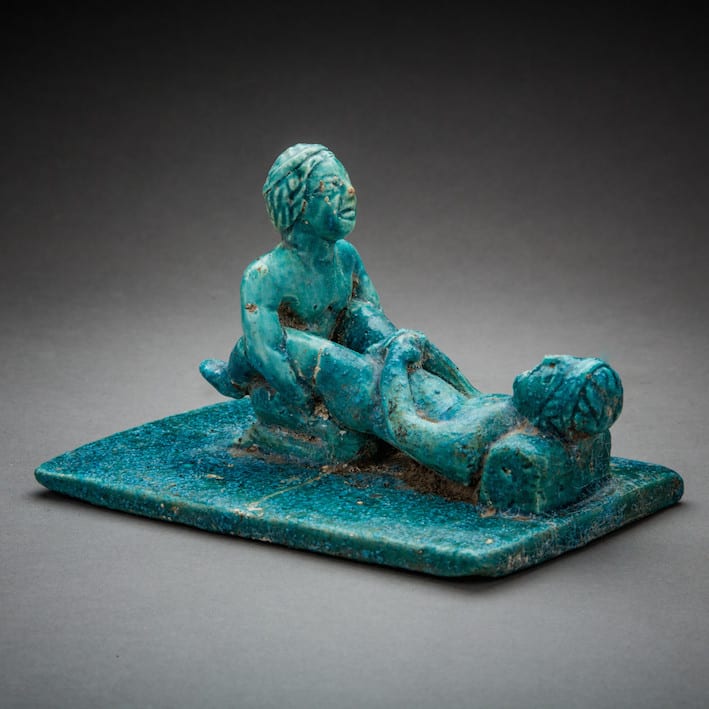Faience figurines of a male couple engaging in sexual activity, 1st Century CE - 3rd Century CE
Faience
11.4 x 18.4 cm
4 1/2 x 7 1/4 in
4 1/2 x 7 1/4 in
LO.1369
Further images
The ideal Egyptian family was a very traditional one, consisting of father, mother and children and such concept was central to society and to official discourse. Regardless of that, we...
The ideal Egyptian family was a very traditional one, consisting of father, mother and children and such concept was central to society and to official discourse. Regardless of that, we sometimes manage to notice glimpses of other relationships existing in spite of all such official attitudes. It remains vastly unclear what exact views Ancient Egyptians fostered about homosexuality, as the term is nowadays intended. All literary documents that actually contain sexually orientated stories, never name the nature of the sexual deeds but instead use rather stilted and flowery paraphrases. On the other hand, ancient Egyptian documents do not show same-sex relationships seen as neither reprehensible nor despicable, nor are there any mentions of homosexual acts as being set under penalty. During the Fourth, Fifth and Sixth Dynasties (ca. 2613-2181 BC) much artistic experimentation took place in the ways that affection could be represented between husband and wife on official monuments and it was during this period that a window of opportunity was adroitly used by two men, who were able to have their own funerary monument constructed as an example of demonstrating male to male intimacy and affection in an otherwise phallocentric society. The tomb inscriptions and frescos of two high offcials, Nyankh-khnum and Khnum-hotep, who both lived and served under the 5th Dynasty pharaoh Niuserre (2494-2345 BC) and who were buried together in the same mastaba are well known and suggest that homosexuality, in terms of sexual orientation, was completely accepted. Regardless of existing evidence that other family members were buried in their tomb, the tomb was expressly built for these two officials to co-habit for eternity, with their wives appearance being completely perfunctory. The scenes of two men embracing and holding hand are unique in private tombs and very little can be said about their meaning beyond the fact that they express publicly the close involvement of these two men, offering us the chance to view the relationship between Nyankh-khnum and Khnum-hotep in a different light.
Our figurines of two men, with the penetrative partner kneeling in front of the receiving partner who is lying on his back, and lifting the receiving partner’s pelvis for penetration, although belonging to a much later period, are to be seen under the same tolerant light. Egyptian faience is a non-clay based ceramic, composed of powdered quartz or sand, with small amounts of calcite lime and a mixture of alkalis, the surface covered with a vitreous glaze and often containing copper pigments to create a bright blue-green luster. Faience has been very widely used for the creation of small objects from beads to statuettes, and is found in both elite and popular contexts.
Our figurines of two men, with the penetrative partner kneeling in front of the receiving partner who is lying on his back, and lifting the receiving partner’s pelvis for penetration, although belonging to a much later period, are to be seen under the same tolerant light. Egyptian faience is a non-clay based ceramic, composed of powdered quartz or sand, with small amounts of calcite lime and a mixture of alkalis, the surface covered with a vitreous glaze and often containing copper pigments to create a bright blue-green luster. Faience has been very widely used for the creation of small objects from beads to statuettes, and is found in both elite and popular contexts.





